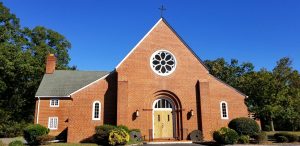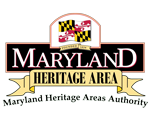St. Peter Claver Roman Catholic Church and McKenna Hall

On June 21,2024, St. Peter Roman Catholic Church and Complex was publicly recognized in a ceremony as a historic site with the receipt of a roadside marker from the State of Maryland. Its history reflects the attitudes and laws in Maryland and the United States.
The origins of the church community are deep and complex being tied to the founding of the State of Maryland and founding of the Catholic Church in Maryland. Its history is a significant part of the larger St. Inigoes Mission that started in the State with the landing of its first settlers.
When on March 25, 1634, the Ark and the Dove landed on St. Clements Island with Father Andrew White, S.J. and Father John Altham, S.J onboard, they said the first Catholic mass in the United States. On March 27, 1634, the site of what would become St. Mary’s City was purchased by Governor Leonard Calvert from the Native Americans. Father Andrew White and Father Altham, both Jesuit Fathers, obtained a hut from the Native Americans and used it as “the first chapel in Maryland.”
Between 1636 and 1638, a wood chapel was built. Then in the 1660’s, a brick chapel named St. Maries Chapel was erected with a cemetery. Both were in the settlement of St. Mary’s City. By the 1640’s, the Jesuit Fathers had moved to their farm, St. Inigoes Manor, about three miles south of St. Mary’s City. The Jesuits had enslaved persons who lived and worked on their farm. The Jesuits, according to research, didn’t refer to them as slaves in their documents; they were referred to as “servants” and “household.” In 1838, the Jesuits sold off their slaves to plantations in the South to pay the debits on their recently founded Georgetown University and establish other universities in America. This event is now referred to as the Georgetown 272+.
When the Maryland penal laws forbidding Roman Catholic churches were passed in 1704, St. Maries Chapel was closed. After the American Revolution, in 1788, St. Ignatius Church on the Manor was dedicated as part of the re-establishment of Catholic parishes. In1881, the parish erected St. Michael’s Church in Scotland, Maryland, but moved it to Ridge Maryland in 1888.
During the “Jim Crow” era, Father Tynan, S. J. of St. Michaels’s organized two sodalities in St. Michael’s parish, one for blacks and one for whites. The black sodality had St. Peter Claver as its patron; the white sodality had St. Michael as its patron.
The St. Peter Claver Sodality met and organized in the home of Benjamin and Maria Biscoe. Within a year, the Sodality erected a meeting hall in 1901 and called it Hilly Road. The foundations for this Sodality Hall remain in the wooded area north of the present parish church. The hall was called St. Peter Claver Sodality Hall. Although there were two Sodalities, separated primarily along racial lines, there was only one place of worship for the Blacks and Whites that was at St. Michael’s Church. Each Sodality had its own choir and organist, but the white choir and organist played at the Sunday Mass at St. Michael’s, although both black and white received communion together each month, whites received first then the black congregation.
Christmas 1902, a dispute erupted when white members of the congregation complained that the Black choir was receiving prominence and the white organist objected to using the same organ. The dispute grew and the result was a split congregation: whites and a few blacks remained at St. Michael’s and most of the blacks left. Mass was held for the Blacks at St. Peter Claver Sodality Hall on January 18,1903. In 1913, three acres of land was purchased from the Biscoe family to build a church. Father Emerick laid the cornerstone for the first Saint Peter Claver Catholic Church on May 7, 1914. On December 1, 1918, the first St. Peter Claver Church was dedicated. Constructed of wood with a tin roof, the church could seat 300. The interior contained three stained glass windows above the main altar; the center one portrayed the crucifixion and was a gift of the Knights of St. Jerome.
The original 1918 church burned in 1934, Philip Frohman, architect of the National Cathedral in Washington, D.C., designed the new church which was completed in 1938. St. Peter Claver is the only predominantly Roman Catholic African American parish in St. Mary’s County.
St. Peter Claver Catholic School was begun in 1916, and was the first Catholic school to provide education opportunities to African American children in St. Mary’s County. The school burned in 1928, was rebuilt, and remained open until 1965. The building, renamed McKenna Hall, is a museum.
